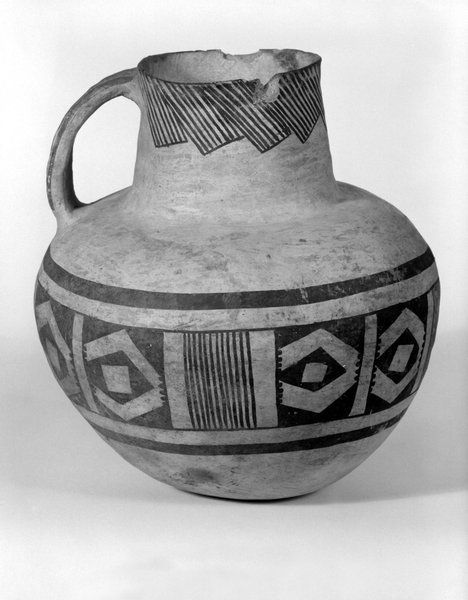Pitcher with Black on White Geometric Design Item Number: 01.1538.1752 from the Brooklyn Museum

Description
Pitcher with handle between lip and shoulder. The bottom of pitcher is plain. Design is black on whitish gray. Handle has four black bands on the parallel coils. Band around center of pot has design sets of diamonds, alternating with vertical stripes enclosed by two thick bands. Shoulder and neck have diagonally slanting parallel lines with saw toothed ends. Mouth is plain. Two chips on rim: long and shallow 3/4" and V-shaped 3/8," opposite each other. Some abrasion of paint, rusty discoloration on one side.
Inscribed
Gummed label: 301 on shoulder, gummed label 1752 on inside of neck. 1/2 of original Culin exhibition label placed inside pot.
Credit Line
Gift of Charles A. Schieren
Label
The Anasazi, ancestors of modern Pueblo peoples now living in New Mexico and Arizona, settled and farmed in the Four Corners region between about A.D. 1 and 1300. Originally, utilitarian Anasazi vessels were basketry, but by A.D. 500, clay that was hand-coiled, smoothed, painted, and baked in open-air fires became the medium of choice. One speculation is that the different black-and-white pottery designs may represent family, clan, or village affiliations, but since few designs are exactly alike, each may simply reflect the individual potter s imagination. This pitcher is a fine example of the thin clay walls that the potter could achieve and the dynamic interplay of line designs.
Item History
- Made between 900 and 1300
What
Who
- Culture
- Ancient Pueblo
Where
- Holding Institution
- Brooklyn Museum
When
- Creation Date
- between 900 and 1300
Other
- Location
- Luce Visible Storage and Study Center, 5th Floor
- Classification
- Food/Drink